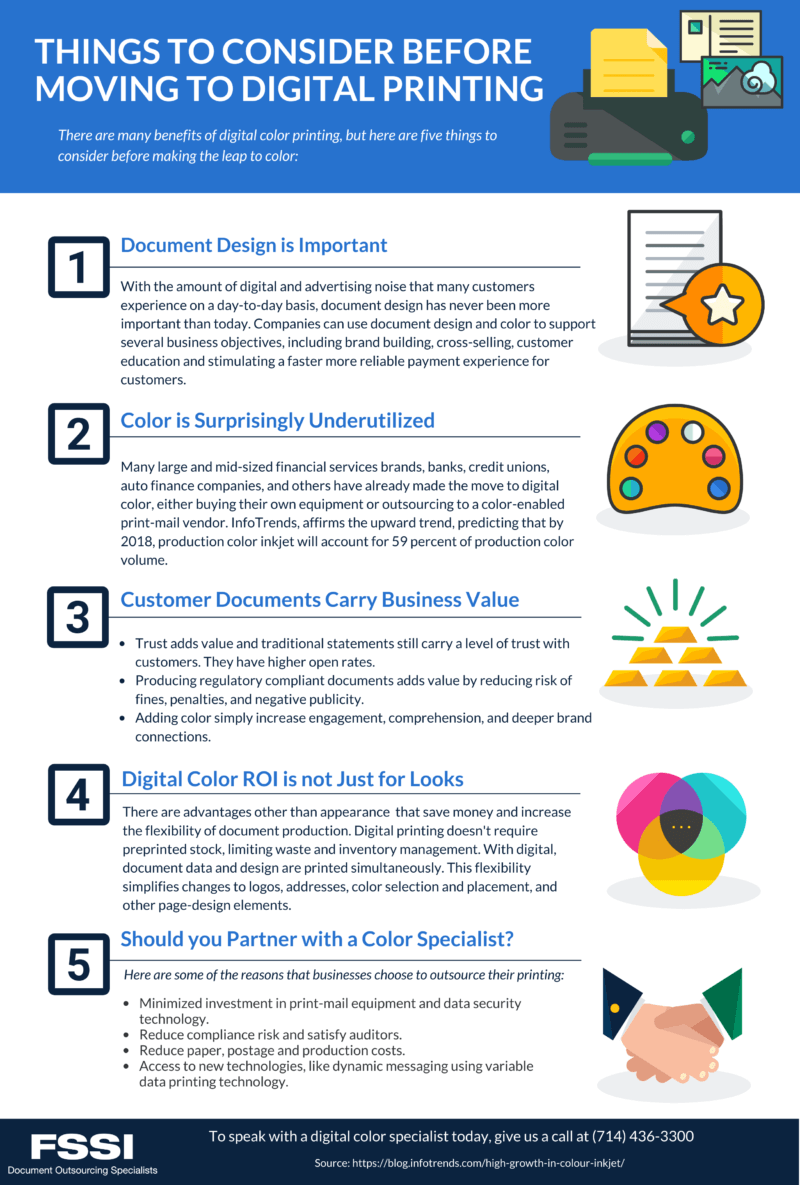8 Easy Facts About Digital Printing Explained
8 Easy Facts About Digital Printing Explained
Blog Article
The Definitive Guide to Digital Printing
Table of ContentsNot known Facts About Digital PrintingDigital Printing - An OverviewThe Ultimate Guide To Digital PrintingThe Greatest Guide To Digital PrintingThe 2-Minute Rule for Digital PrintingDigital Printing Can Be Fun For Anyone
Variable information printing, such as direct mail with customized codes and addresses, is preferably fit for electronic printing. Digital quick printing only needs four actions of layout, review, printing and binding to get whatever done. Digital quick printing has an unrivaled advantage: print on demand.According to PMMI, electronic printing allows brand names and suppliers to respond quickly to customer needs while boosting the supply chain, lowering warehousing expense and waste, and appreciating faster time to market. That all sounds fantastic, however just how does this innovation do all that? The significant differentiator of these innovations is that there are no set up costs and no plates with digital printing.
The 15-Second Trick For Digital Printing
According to Wikipedia, the biggest distinction between digital printing and standard techniques such as lithography, flexography, gravure, or letterpress - Digital Printing is that there is no requirement to change printing plates in digital printing, whereas in these analog printing techniques the plates are continuously changed. This causes quicker turnaround time and reduces cost when utilizing electronic printing.
Digital printing is highly adaptable, so it's easy to make modifications to the bundle style promptly. It all goes back to the plates.
More inventory can indicate even more waste later on. With conventional printing methods, short-run printing is just not possible. Since a fantastic layout can make or damage your item, electronic printing regularly develops high-quality, clear and colorful graphics each time. Digital printing on versatile pouches includes the brilliant, dynamic, and exact graphics that almost beckon customers to reach out and touch them.
Digital printing is the procedure of printing digital-based photos directly onto a selection of media substrates. There is no demand for a printing plate, unlike with countered printing. Digital files such as PDFs or desktop publishing files can be sent directly to the digital printing press to print theoretically, image paper, canvas, fabric, synthetics, cardstock and various other substratums.
Excitement About Digital Printing
According to PMMI, electronic printing enables brands and suppliers to react swiftly to consumer demands while enhancing the supply chain, minimizing warehousing price and waste, and appreciating faster time to market. you could try here That all noises excellent, but exactly how does this technology do all that? The significant differentiator of these modern technologies is that there are no set-up costs and no plates with digital printing.
According to Wikipedia, the biggest difference in between digital printing and traditional approaches such as lithography, flexography, gravure, or letterpress is that there is no requirement to replace printing plates in digital printing, whereas in these analog printing approaches the plates are continuously replaced. This leads to quicker turn-around time and reduces expense when using digital printing.

Everything about Digital Printing
With conventional printing methods, short-run printing is just not possible. Due to the fact that a great design can make or damage your item, digital printing continually creates top quality, clear and colorful graphics each time.

According to PMMI, electronic printing permits brand names and makers to react rapidly to customer demands while improving the supply chain, decreasing warehousing expense and waste, and appreciating faster time to market. That all sounds terrific, but exactly how does this innovation do all that? The major differentiator of these technologies is that there are no set-up fees and no plates with electronic printing.
A Biased View of Digital Printing
This results in quicker turnaround time and reduces price when making use of electronic printing.
Rapid production implies obtaining your product to market much faster. It likewise implies it's easier and faster to make changes in the view publisher site future, when you change a dish, add a SKU, or produce seasonal product packaging. Digital printing is extremely flexible, so it's easy to make adjustments to the bundle style rapidly. It all goes back to the plates.

9 Easy Facts About Digital Printing Shown
Digital printing is the procedure of printing digital-based pictures straight onto a variety of media substratums. There is no need for a printing plate, unlike with countered printing. Digital files such as PDFs or desktop publishing files can be sent directly to the electronic printing press to publish on paper, photo paper, canvas, fabric, synthetics, cardstock and various other substrates.
Report this page